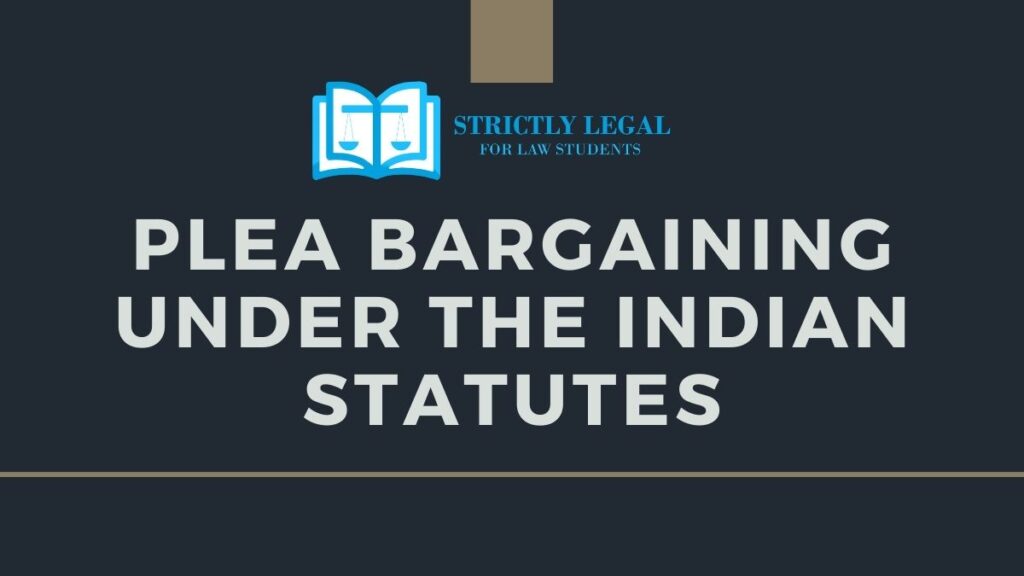Almost every law student knows about the well-known saying “justice late is justice denied”. That very famous saying holds uttermost importance in Plea Bargaining. As the number of cases hovering and pending before the Honorable Courts of the country is hard to believe in human ears. However, people have more likely to accept this as their fortune and that this is how justice is served. Fortunately, Plea Bargain after being introduced in the country does work as a boon to people in need as the term itself says, it is an agreement between the accused and the prosecutor. Maximum countries have included “Plea Bargaining” as a concept in their Criminal Justice systems.
Table of Contents
Understanding the term “Plea Bargaining”
In simple words, Plea Bargaining is a mutual negotiation between the accused in issue and the prosecutor in the opposite party where the accused in his own will concurs to plead guilty in return for certain forfeits or adjustments from the prosecution. It is a bargain or a negotiation where the defendant pleads guilty for a charge which would be way lesser than the verdict would have been. However, plea bargaining won’t be a matter to escape where the defendant has committed heinous crimes or the crimes whose natural punishment is life imprisonment or capital punishment.
However, when India followed the Jury System in the Criminal Justice System, the need for Plea Bargaining was never felt because there was no legal representation back then. Later on, around the 1960s the concept of Plea Bargaining was the need of the hour. It was mostly used by the Honorable Judges to promote confessions in the Criminal Justice System.
Plea Bargaining in India
Plea Bargaining is not a native concept of the Indian Criminal Justice System, rather it is a part of all the recent developments after considering and witnessing the burden of long-standing cases on the Judiciary.
In India, the statute for Plea Bargaining is mentioned in Chapter XXIA of the Code of Criminal Procedure, 1973 [herein after referred to as the Act].
As mentioned above, Plea Bargaining might seem the easiest form to seek early and quick justice, however, it does not apply to each and every case in India. Plea Bargaining in India is allowed in cases where:
- The maximum punishment for imprisonment is for 7 years,
- The offences do not affect the socio-economic condition of the country,
- The offences aren’t committed against a woman or child aged below 14 years.
Plea Bargaining was introduced in India by the Malimath Committee when the NDA government formed a committee to handle the issue of overcrowding of cases in India. The Former Chief Justice of Karnataka and Kerala High Court, Justice V.S. Malimath headed the committee. The committee then gave a proposal to introduce the concept of “Plea Bargaining” in India. In the opinion of the committee, Plea Bargaining would not only help reduce and settle the cases at an easier pace but would also ease the disposal of criminal cases.
Correspondingly, the draft of the Criminal Law (Amendment) Bill, 2003 was put forward in the Parliament and hence after all the reviews and addressing the loopholes, it became enforceable in the Criminal Law of India on July 5, 2006. It seeks to amend the Indian Penal Code, 1860 (IPC); the Code of Criminal Procedure, 1973 (CrPC) and the Indian Evidence Act, 1872 (IEA) to ameliorate the already existent Criminal Justice System in India which is overwhelmed with the increasing plethora of Criminal Cases in the country with the rise in population and crime rates.
The Criminal Law (Amendment) Bill, 2003 proposed for the following key points to be amended:
- Hostile Witnesses
- Plea Bargaining
- Compounding the Offense u/s 498A IPC
- Evidence of scientific experts
Finally, the idea of introducing plea bargaining in India was accepted and inserted as Chapter XXIA in the Act.
Types of Plea Bargaining
Plea Bargaining is further has its three types. They are as follows:
Sentence Bargaining
This is the category of Plea Bargaining where the aim is to hold a lesser sentence. Here, the defendant pleads guilty to the alleged charges and in exchange for that, he demands for a lesser sentence of punishment.
Charge Bargaining
This category of Plea Bargaining deals with exchanging of getting lesser severe charges to the accused which happens to be the most usual form of Plea Bargaining in Criminal Cases. The accused/ defendant agrees to plead guilty to a lesser charge to him in the deliberation of dismissal of severe charges against him.
Fact Bargaining
This category of Plea Bargaining is usually not used in the Courts of Law in India as it is believed and claimed to be against the Criminal Justice System. It happens when the accused/ defendant sets forth certain facts on account of refraining from other facts to be introduced as another piece of evidence in the Court.
Legal Provisions for Plea Bargaining in India under CrPC
Section 265A: Plea Bargaining is offered to the accused who is charged with any criminal offence other than the offences mentioned above where Plea Bargaining cannot be provided.
Section 265A (2): Gives the power to notify the Government of India (Central Government) about the offences.
Section 265B: Application of Plea Bargaining that is to be filed by the accused/ respondent, which shall include a very brief detail of the cases and the offences to which the case connects, along with the affidavit of the accused/ respondent. The court shall issue a notice to the Investigating Officer, Public Prosecutor and the victim of the case, thereafter.
Section 265C: Describes the process of the Court in warming up a consensual disposition of the case.
Section 265D: A meeting is organized and after that, a consensual disposition of the case is decided by maintaining a report which is signed by the presiding officer as well as the participants of the meeting.
Section 265E: After the preparation of reports, the Court of Law will hear both the parties to the case to reach a decision for ruling on the quantum of punishment required for the accused.
Section 265F: Deals with verdicts with regards to consensual disposition.
Section 265G: No appeal can be made against such a verdict.
Section 265H: Power of the Court of Law in Plea Bargaining.
Section 265I: Section 428 applies to disposition awarded to the accused.
Section 265J: Not tolerating any inconsistency therewith contained in any other provisions of the Code and nothing in such other provision shall be made up to contain the meaning of any provision of Chapter XXIA of CrPC.
Section 265K: Statements given by the accused/ respondent cannot be used for any other purpose.
Section 265L: This act shall not apply in any case filed under the Juvenile Justice Act, 2000.
Conclusion:
The concept of Plea Bargaining is not entirely new in India, rather India had already recognized plea bargaining when it received its own Constitution as Article 20 (3) prevents self-incrimination. With the passage of time, keeping in mind the burden of the court to provide justice to the people in need at the earliest, this concept has slowly and gradually been accepted by the people.

Law student.
Turning legal insights into engaging narratives.





